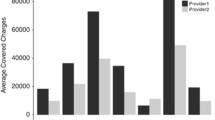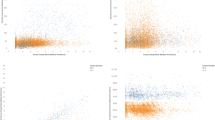Abstract
Risk-adjusted capitation rates based on a group's expected cost to a provider have been proposed to create incentives for including people with severe mental disabilities in managed healthcare systems. The most appropriate methods for classifying people according to levels of risk, however, have yet to be determined. This research employed cluster analysis statistical techniques to identify patterns of services delivered to a sample of 4,346 consumers in Ohio. Findings about the extent of client movement in and out of service clusters over time suggest caution in the implementation of risk-adjusted capitation plans, particularly those based primarily on past service utilization.
Similar content being viewed by others
REFERENCES
Anderson, G. F., Steinberg, E. P., Powe, N. R., Antebi, S., Whittle, J., Horn, S., & Herbert, R. (1990). Setting payment rates for capitated systems: A comparison of various alternatives. Inquiry,27, 225–233.
Arons, B. S., Frank, R. G., Goldman, H. H., McGuire, T. G., & Stephens, S. (1994). Mental health and substance abuse coverage under health reform. Health Affairs, Spring, 192–205.
Ash, A., Porell, F., Gruenberg, L., Sawitz, E., & Beiser, A. (1989). Adjusting Medicare capitation payments using prior hospitalization data. Health Care Financing Review,10(4), 17–29.
Christianson, J. B., & Osher, F. C. (1994). Health maintenance organizations, health care reform, and persons with serious mental illness. Hospital & Community Psychiatry,45, 898–905.
Frank, R. G., & McGuire, T. G. (1994). Establishing a capitation policy for mental health and substance abuse services in healthcare reform. Behavioral Healthcare Tomorrow, July/August, 36–39.
Hadley, T.R., Culhane, D.P., & McGurrin, M.C. (1992). Identifying and tracking “heavy users” of psychiatric inpatient services. Administration and Policy in Mental Health,19, 279–290.
Kent, S., Fogarty, M., & Yellowlees, P. (1995). Heavy utilization of inpatient and outpatient services in a public mental health service. Psychiatric Services,46, 1254–1257.
Kessler, L.G., Steinwachs, D.M., & Hankin, J.R. (1980). Episodes of psychiatric utilization. Medical Care,18, 1219–1227.
Landress, H. J., & Bernstein, M. A. (1993). Managed care 101: An overview and implications for psychosocial rehabilitation services. Psychosocial Rehabilitation Journal,17(2), 5–14.
Lehman, A. F. (1987). Capitation payment and mental health care: A review of the opportunities and risks. Hospital & Community Psychiatry,38, 31–38.
McGuire, T. G. (1989). Financing and reimbursement for mental health services. In C. A. Taube, D. Mechanic, & A. A. Hohmann (Eds.),The future of mental health services research, pp. 87–111 (DHHS Publication No. ADM 89-1600). Washington, DC: U.S. Government Printing Office.
McGuire, T. G. (1994). Predicting the cost of mental health benefits. The Milbank Quarterly,72(1), 3–23.
McGuire, T.G., & Fairbank, A. (1988). Patterns of mental health utilization over time in a fee-for-service population. American Journal of Public Health,78, 134–136.
Mechanic, D. (1994). Integrating mental health into a general health care system. Hospital & Community Psychiatry,45, 893–897.
Newhouse, J. P., Manning, W. G., Keeler, E. B., & Sloss, E. M. (1989). Adjusting capitation rates using objective health measures and prior utilization. Health Care Financing Review,10(3), 41–54.
Reed, S. K., Hennessy, K. D., & Babigian, H. M. (1995). Setting capitation rates for comprehensive care of persons with disabling mental illness. Psychiatric Services,46, 127–129.
Reed, S. K., Hennessy, K., Brown, S. W., & Fray, J. (1992). Capitation from a provider's perspective. Hospital & Community Psychiatry,43, 1173–1175.
Roth, D., Lauber, B. G., Crane-Ross, D., & Clark, J. A. (1997). Impact of state mental health reform on patterns of service delivery. Community Mental Health Journal,33, 473–486.
Roth, D., Lauber, B. G., Vercellini, J., Frazier, M., & Hogan, M. F. (1995). Final results: Ohio's study of services, systems and outcomes in an era of change. In Proceedings of the Fifth Annual National Conference on State Mental Health Agency Services Research and Program Evaluation (pp. 85–103). Alexandria, VA: The National Association of State Mental Health Program Directors Research Institute, Inc.
Scheffler, R., Grogan, C., Cuffel, B., & Penner, S. (1993). A specialized mental health plan for persons with severe mental illness under managed competition. Hospital & Community Psychiatry,44, 937–942.
Schinnar, A. P., Rothbard, A. B., & Hadley, T. R. (1992). A prospective management approach to the delivery of public mental health services. Administration and Policy in Mental Health,19, 291–308.
Wells, K. B., Keeler, E., & Manning, W.G. (1990). Patterns of outpatient mental health care over time: Some implications for estimates of demand and benefit design. Health Services Research,24, 773–789.
Author information
Authors and Affiliations
Rights and permissions
About this article
Cite this article
Roth, D., Snapp, M.B., Lauber, B.G. et al. Consumer Turnover in Service Utilization Patterns: Implications for Capitated Payment. Adm Policy Ment Health 25, 241–255 (1998). https://doi.org/10.1023/A:1022235221304
Issue Date:
DOI: https://doi.org/10.1023/A:1022235221304




